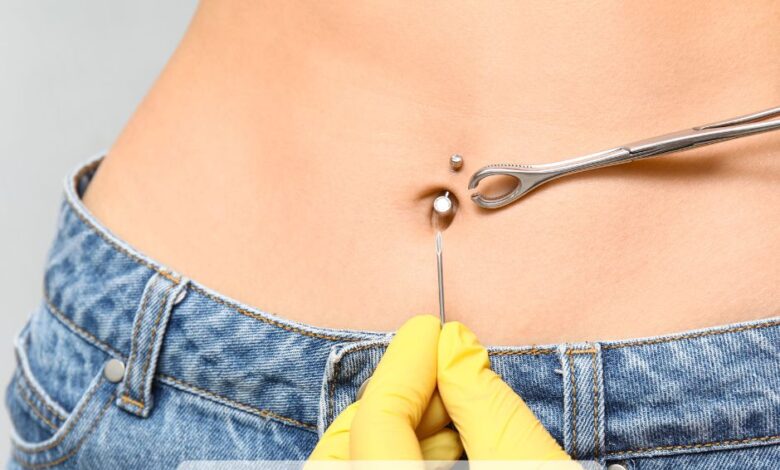
“Learn how to treat an infected belly button piercing with effective home remedies and professional care tips. Protect your piercing and promote healing fast.”How To Treat an Infected Belly Button Piercing: Effective Tips and Remedies
Getting an infected belly button piercing can be really frustrating. But, knowing how to treat it is key to getting better fast. An infected piercing needs quick attention to avoid more problems. If you see signs of an infection, it’s important to act fast and learn how to treat it right.
It’s crucial to know the signs of an infected piercing. This way, you can start treating it and help it heal. Learning how to treat an infected piercing will help you get it back to health.
Key Takeaways
- Recognize the signs and symptoms of an infected belly button piercing
- Learn how to treat an infected belly button piercing at home
- Understand the importance of proper cleaning and aftercare
- Know when to seek professional medical help for an infected belly button piercing
- Take preventive measures to avoid future infections
- Follow a daily care routine to promote healing and prevent complications
Signs of an Infected Belly Button Piercing
Knowing the signs of an infected belly button piercing is key. It helps you get treatment fast and avoid bigger problems. Infections can happen due to bad aftercare, dirty conditions, or low-quality jewelry. If you think your piercing is infected, look for signs like redness, swelling, and discharge. These might need special treatment.
Common signs of infection include redness and swelling around the piercing. You might also see discharge or pus and feel increased sensitivity or pain. Treating these symptoms is important to stop the infection from getting worse.
Common Infection Symptoms
- Redness and swelling around the piercing site
- Discharge or pus oozing from the piercing
- Increased sensitivity or pain in the affected area
Severe Symptoms Requiring Medical Attention
Some infections can cause serious symptoms that need a doctor. Look out for increased pain or swelling, fever, or difficulty moving the area. If you see these, get medical help right away. They can help prevent more serious problems and treat your infection.
Differentiating Between Normal Healing and Infection
Telling normal healing from an infection can be hard. But, watching your piercing closely is crucial. If you’re not sure, it’s best to talk to a professional piercer or doctor. They can guide you on treatment and how to prevent infections.
How To Treat an Infected Belly Button Piercing at Home
When treating infected belly button piercing, it’s key to follow a clear guide. This ensures the right care and prevents more problems. For mild infections, home treatment can work well. But, always watch the infection and get medical help if it gets worse.
To begin, clean the infected spot with a saline solution. Mix 1/4 teaspoon of sea salt with 8 ounces of warm water. Soak a clean cloth in it and place it on the area for 5-10 minutes, 2-3 times a day. This helps reduce swelling and aids in healing.
Along with cleaning, there are over-the-counter treatments that help. These include:
- Antibiotic ointments to fight bacteria
- Hydrocortisone cream for itching and swelling
- Tea tree oil to heal and prevent infection
It’s also vital to keep the area dry and avoid tight clothes. Following these steps and watching the infection can help treat it at home. This way, you can speed up the healing process.
Essential Cleaning Solutions and Products
When you have an infected belly button piercing, it’s key to use the right cleaning solutions. This helps the piercing heal and stops more infection. Use a saline solution or a mild soap that’s fragrance-free and gentle.
Stay away from harsh chemicals and fragrances. They can irritate the skin and slow healing. Choose safe, gentle cleaning solutions made for piercings.
Safe Cleaning Solutions
Safe options include saline solution, mild soap, and piercing aftercare sprays. These are gentle and help reduce inflammation. Always check the label for fragrance-free and hypoallergenic ingredients.
Products to Avoid
Don’t use harsh chemicals, fragrances, or dyes. They can irritate the skin and slow healing. Avoid hydrogen peroxide, bleach, and harsh soaps.
Recommended Aftercare Products
For healing and preventing infection, use aftercare products. Look for piercing aftercare sprays, creams, and ointments. Brands like NeilMed and H2Ocean are good choices. Make sure they’re gentle and fragrance-free.
Proper Cleaning Techniques and Frequency
Proper cleaning is key when treating an infected belly button piercing. Infected navel piercing treatment needs patience and regular cleaning. Cleaning the piercing often helps it heal and prevents more infections.
To clean right, soak the piercing in a saline solution. Then, gently clean it with mild soap. Stay away from harsh chemicals and rough cloths to avoid irritation. Here are some helpful tips:
- Clean the piercing 2-3 times a day
- Use a saline solution to soak the piercing
- Avoid using harsh chemicals or rough cloths
By sticking to these tips and cleaning regularly, you can help your piercing heal. Remember, treating infected belly button piercing takes time and effort. But with the right cleaning and care, you can have a healthy and happy piercing.
When to Seek Professional Medical Help
Some belly button piercing infections can be treated at home. But, severe cases need medical help. Knowing when to seek help is key to avoid complications and ensure healing.
If you see more pain, swelling, or discharge, it might be a sign of a serious infection. In such cases, seeing a doctor or healthcare provider is crucial. They can diagnose and treat the infection properly.
It’s important to know how to treat an infected belly button piercing. But, knowing when home remedies are not enough is also vital. A belly button piercing infection can cause serious health problems if not treated on time. So, it’s important to recognize emergency signs and act quickly.
Emergency Warning Signs
- Increased pain or tenderness around the piercing
- Swelling, redness, or inflammation
- Thick, yellow, or green discharge
- Fever or chills
If you notice any of these symptoms, get medical help right away. A healthcare provider can give the right treatment and advice on how to treat an infected belly button piercing. Remember, quick medical attention is crucial to avoid more problems and help healing.
Finding a Qualified Healthcare Provider
When looking for medical help, find a healthcare provider experienced in piercing infections. Ask friends, family, or your doctor for recommendations. Make sure the provider is licensed and has a good reputation.
Prevention Tips for Future Infections
To keep your belly button piercing healthy, follow a daily care routine. Clean it with a saline solution and avoid tight clothes. Proper aftercare is key to preventing infections and promoting healing.
Preventing infections in your belly button piercing requires attention and good hygiene. Simple lifestyle changes can help. Avoid swimming during the healing period and wear loose clothes to prevent irritation.
Daily Care Routine
- Clean the piercing with a saline solution 2-3 times a day
- Avoid using harsh soap or chemicals that can irritate the area
- Pat the area dry with a clean towel after cleaning
Lifestyle Adjustments
Simple lifestyle changes can prevent infections and promote healing. Avoid activities that irritate your piercing, like swimming. Also, choose loose, comfortable clothing to reduce irritation.
Common Mistakes to Avoid During Treatment
When treating an infected belly button piercing, it’s key to avoid common mistakes. Proper aftercare is vital to prevent more infection and help healing. A big mistake is over-cleaning or under-cleaning the piercing. Using harsh chemicals or ignoring the infection can also cause problems.
To steer clear of these errors, stick to a regular cleaning routine. Use gentle, fragrance-free soap. It’s also crucial to monitor the infection closely and get medical help if symptoms get worse. Understanding the importance of proper aftercare and avoiding common mistakes is key when learning how to treat an infected belly button piercing.
Some common mistakes to avoid during infected navel piercing treatment include:
- Using harsh chemicals or abrasive materials to clean the piercing
- Neglecting to clean the piercing regularly
- Tightening or loosening the jewelry too frequently
- Touching the piercing with unwashed hands
By avoiding these common mistakes and following proper aftercare, you can aid in healing and prevent more infection. Always prioritize proper hygiene. Seek medical attention if you face severe symptoms or complications during healing.
Conclusion: Managing Your Piercing Health Long-Term
Keeping your belly button piercing healthy is a long-term commitment. It needs patience, consistency, and the right care. Even after it heals, keep up with good hygiene and watch for infection signs.
Use a saline solution to clean it regularly and stay away from things that might irritate it. Also, listen to your body. If you notice any problems, get help from a medical professional right away.
Your piercing’s health is very important. By following the advice in this article and being active with your care, your belly button piercing will stay healthy for a long time.
FAQ
What are the signs of an infected belly button piercing?
Signs of an infected belly button piercing include redness, swelling, and pain. You might also notice warmth and discharge. If you have increased pain, fever, or chills, seek medical help right away.
How can I treat an infected belly button piercing at home?
For mild infections, start by gently cleaning the piercing with a saline solution or mild soap and water. Use a warm compress to help. Avoid anything that might irritate it. Watch the piercing closely and see a doctor if it gets worse or doesn’t get better.
What cleaning solutions and products are safe to use on an infected belly button piercing?
Safe cleaning solutions include sterile saline solution and mild, fragrance-free soap. Stay away from harsh chemicals, alcohol, and other products that could irritate the piercing.
How often should I clean an infected belly button piercing?
Clean the piercing 1-2 times a day. Use gentle techniques to avoid over-cleaning, which can slow healing.
When should I seek professional medical help for an infected belly button piercing?
If the infection gets worse, with more pain, swelling, redness, or fever, see a doctor. They can assess and treat the infection properly.
How can I prevent future infections in my belly button piercing?
To prevent infections, clean the piercing daily and avoid water submersion. Wear loose, breathable clothes and make lifestyle changes to reduce irritation. If you’re worried about the piercing’s health, get professional advice.
What are some common mistakes to avoid when treating an infected belly button piercing?
Don’t over-clean, use harsh chemicals, or ignore the infection. Clean properly, take care of it, and be patient for it to heal.



